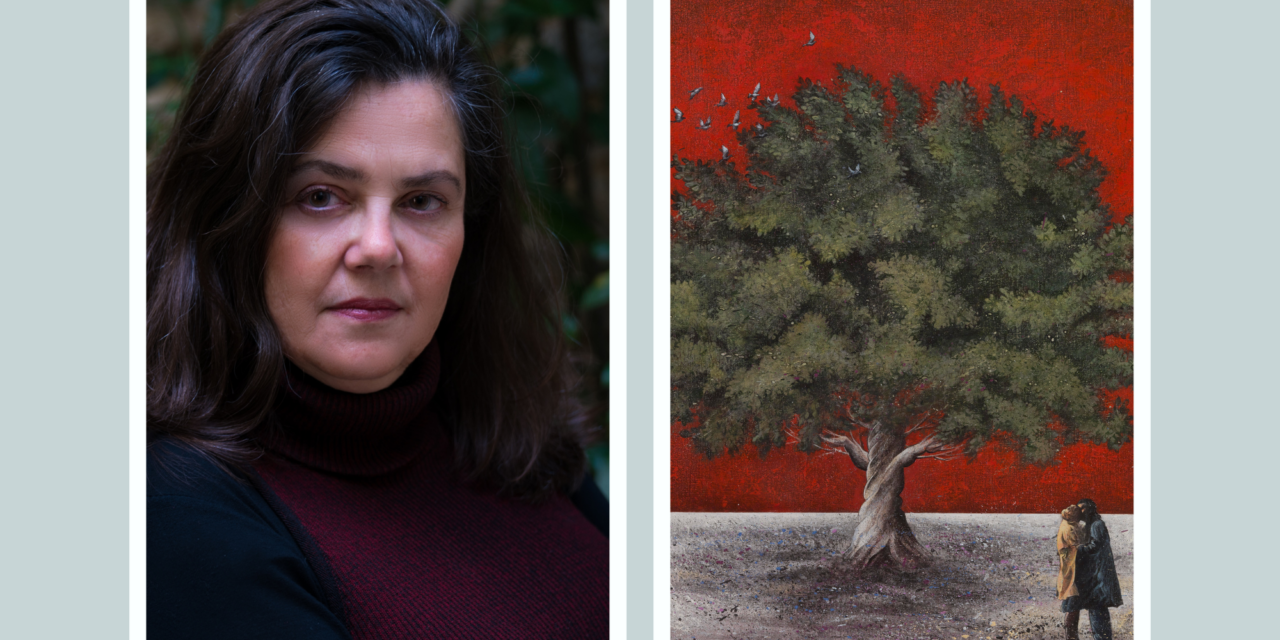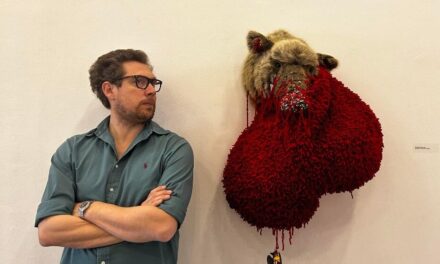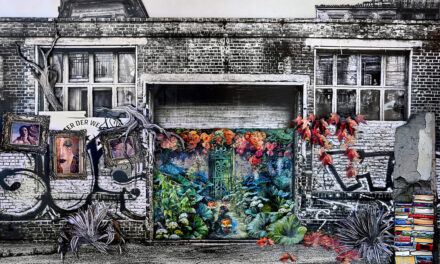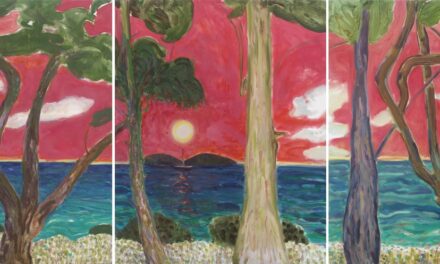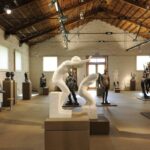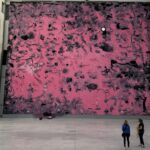Daphni Angelidou is a renowned Greek painter and professor of mosaics at the Athens School of Fine Arts. Her artwork has profound emotional depth offering a visual narrative of healing, resilience, and hope.
Through a unique blend of techniques, her paintings capture the essence of fleeting moments and desolate spaces. Her images feature evocative scenes that lend her work a dreamlike, atmospheric quality that mirrors the fluidity of time. Through her art, she encourages viewers to embrace life’s contrasts. Her paintings serve as beacons of hope, reminding us that even in our darkest moments, there is light to be found.
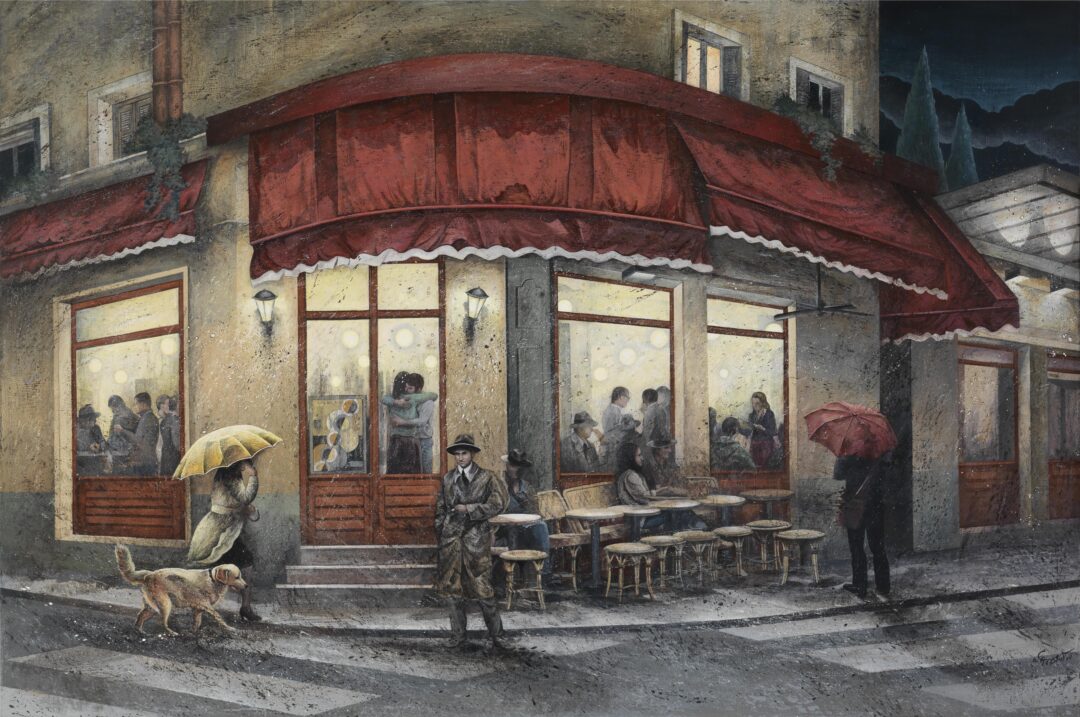
Angelidou prefers to work at night, “when all interesting things happen”, when senses get heightened. Her subject matters are, in one way or another, related to the still of the night. Illuminated landscapes, solitary nighthawks, urban cafes, house facades, couples in love or search of love are part of an almost cinematographic atmosphere where “darkness has its own light”. Time, memory and desire play a crucial role in her art. She loves to play with light, shadows and reflections. Recurring symbols such as umbrellas, lanterns and bus stops assume a special role, contributing to an intentional ambiguity and crafting a world where reality merges with the imaginary.
Her pieces inspire a sense of solace and illumination as they beautifully evoke feelings of love, desire, nostalgia, solitude and isolation and invite the viewer into an enchanting nocturnal world where everything is possible. Her compositions are both imaginative and grounded, reflecting a harmonious blend of technical skill, intuitive imagination and a deep sense of artistic storytelling.
Daphni Angelidou was born in Athens in 1962. She studied painting, at the Athens School of Fine Arts (1980-1986) under Moralis and Mytaras, and mosaic, under Kolefas. She has been teaching in the Department of Mosaic at the ASFA since 1987.
She has presented 15 solo exhibitions, a retrospective exhibition at the National Archaeological Museum, “Mosaics of Today”, in 2013, and has participated in many group exhibitions in Greece and abroad. Her works are included in public and private collections, museums and art galleries in Greece and abroad.
Daphni Angelidou loves to share her views about her art and life, as well as her profound knowledge of the art of mosaics. She speaks to Greek News Agenda* about the “painting for eternity” and her visual narratives.
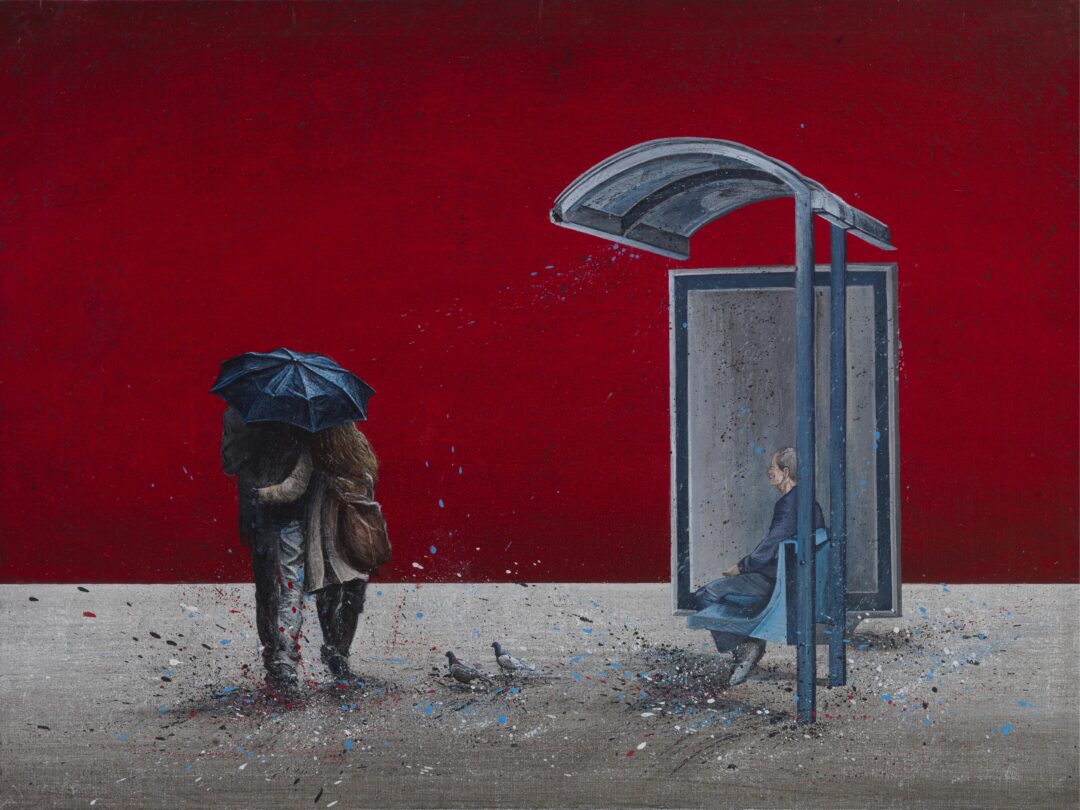
What drew you to the art of mosaic, the “painting for eternity”?
Mosaic is a complicated art and technique. If the artist does not have the required expertise and knowledge of this difficult material/medium, the result can be “insulting” to art. All the old mosaic artists knew this, and perhaps that is why it was a very “exclusive” and expensive profession.
The art of mosaic is described as the “painting for eternity,” based on the fact that many ancient paintings are known thanks to their “copies” in mosaic. History teaches us that all the glorious Ancient, Roman, and Byzantine emperors conveyed the philosophy of their time through the art of mosaics. In Byzantine monuments, mosaics were the ultimate form of expression of the new religion, which they approached in a symbolic and exquisitely minimalist way.
This ancient and charming art is very costly due to its time-consuming and demanding technique as well as the high price of tesserae. It has its own rules and does not simply imitate painting. It is an autonomous, contemporary art that, in a way, replicates the modern world. After all, our world is a vast mosaic of different nationalities, religions, arts, and views. At the same time, it is closely related to contemporary rhythms, and simplification, and stands out with its expressive power.
Today, there is again a “golden” age of the medium of mosaic. Huge and magnificent mosaics are being made in private and public spaces, subways, squares and business premises. They cover the facades or interior walls of buildings of enormous dimensions. They are placed as sculptures in gardens and museums with a unique dual sense of design and color. Mosaics have the unique quality of being used outdoors, they can be made from expensive or cheap material and can cover sculptural forms. Large companies commission mosaic works by famous artists, e.g. huge murals with colorful enamel mosaics at the Four Seasons Hotel in Chicago, covering all the walls with works by Chagall; or the amazing Chuck Close portraits in the New York City subway, along with at least 400 other large-scale mosaics, works by famous artists. All this, of course, in countries that respect culture and have considerable public and private funding for the arts.
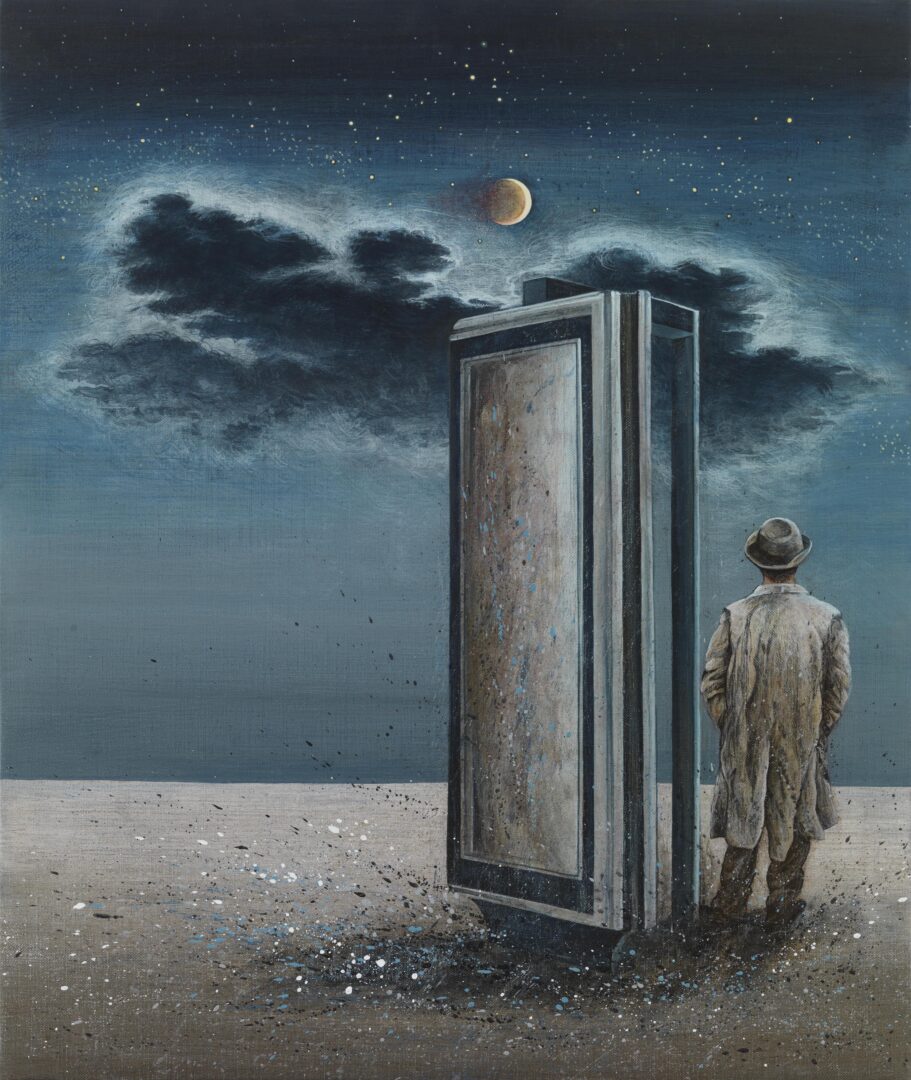
Many of your paintings focus on human relationships against the backdrop of the mystery and charm of the night and the urban landscape. To what extent are your personal experiences and perceptions embodied in your works?
Anyone who works at night understands that loneliness plays a crucial role. I work best in the evening hours. Once I enter my studio and close the door, a parallel life begins to unfold. One project gives birth to another, through my journey, which is often independent of real life because my memory and my view of things change the actual events. The same event is perceived in different ways as each person remembers it differently. Time has a pace of its own. My work evolves as a single work made up of many pieces. Just like a big mosaic. I try to capture the big picture.
I think all the interesting things happen at night. Night scenes and illuminated facades of houses or cafes are my favorite subject matters. I like the different sources of light, e.g. the round porcelain lights of old cafes that rival the moon or the cool lights created by the reflections of lights on worn-out walls.
My goal is to draw bright and colorful nights that illuminate my Mediterranean landscapes and symbolize the warm light of human relationships. That’s why my figures or my “heroes”, as I call them, walk alone, in groups or in pairs through the cities, embracing or kissing in cafes surrounded by shadows. My cafés are meeting places but also places of desire. Sometimes I aspire to create a cinematic atmosphere and narrative. Especially the polyptychs remind me of different scenes – moments from the same film.
The context in which I place the “heroes” of my works is almost always at night because it is the time when people “wake up”. It’s the time of thoughts, feelings, communication with each other, joy and sorrow, creation and memory. My works are about memory and desire. The desire that is based on human communication, and has nothing to do with everyday needs but with love; and love is identified with life itself. The title of my last exhibition “Geography of the night”, is symbolic, a kind of map, through which you can read the night sky, guided by the constellations or the illuminated interiors of the night cafes, but also by the precious human feelings, to reach the core of your existence, which is memory and desire.
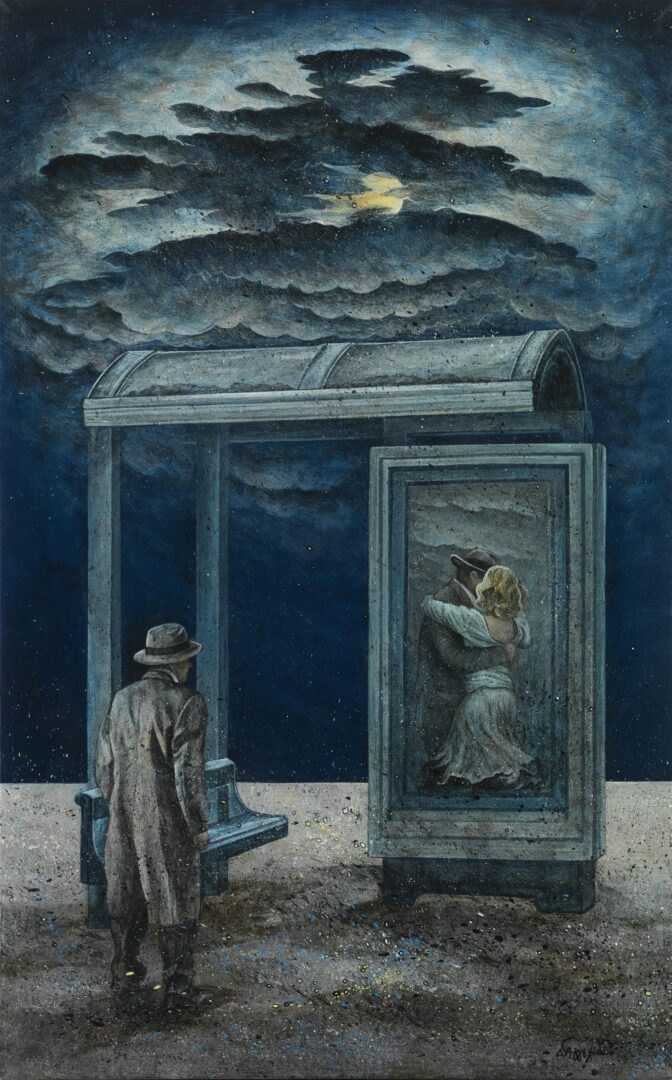
Your paintings often include umbrellas, bus stops, starry skies, red backgrounds, evening trams coming or going. What human conditions do these symbols refer to?
The celestial canopy with its glowing constellations or the dark night that covers us all, is an element that particularly fascinates me. It symbolizes for me the common human destiny. We are all united by the calm and solitude of the night.
The red background is the color of blood and refers to our biological cycle. It unites us when we have worries and anxieties, but also when we rejoice and live our lives through the emotions that flow from human communication, precious friendship and love between us. At night I have the peace of mind to see myself from a distance. I believe that these are the most “alive” times for most of us, because we become aware of the events of the day, and our logic or emotions bring up our fears, dreams and desires.
Excessive use of social media demonstrates a lack of communication. People experience loneliness much more now, when they are constantly in a crowd. I remember a Tom Waits song that goes: “If you don’t want these arms to hold you, if you don’t want these lips to kiss you […] put me back in the crowd”. It’s a wonderful song, and it speaks about the fear we all have after a significant relationship to find ourselves not alone, but in the crowd again. Which seems worse than “alone”.
But in my work, I don’t just talk about loneliness. I also talk about the loneliness we have within us that leads us to a standstill. We stand for a very short time to look at a dark sea, a lit tram coming or going and symbolizing time, a big tree casting its round shadow on the ground, or the bright facades of my cafes, in the lonely wanderings of the gaze in dark cities. I want my works to create a gaze in the fast-paced times we live in. I want people to perceive the bright parts of my paintings as a promise of life and joy. We need that.
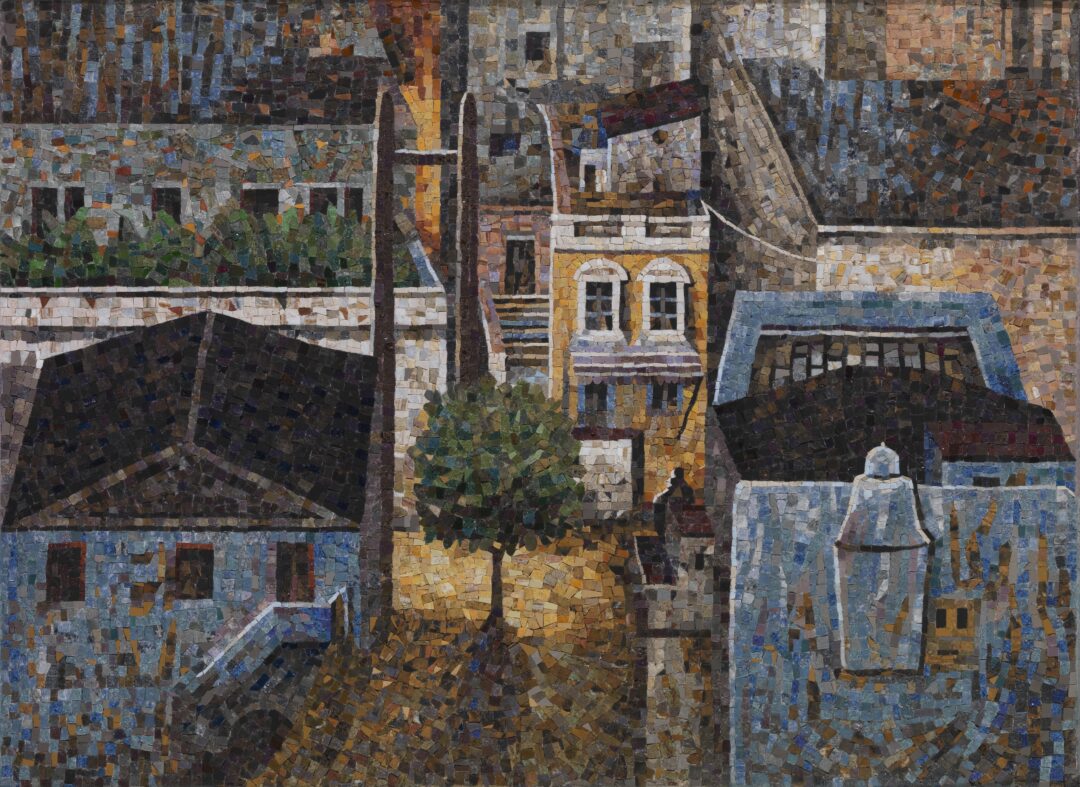
Your works emphasize the dreamy side of things. What’s the role of dualities and shadows in this respect?
Sometimes I paint only what someone is looking at, without focusing on that person. Like in my work The Café and the Cloud, which was exhibited at Art Athens 2020. Three men are sitting at the illuminated café around the same table. Their shadows can be seen from outside. The rest of the painting shows a full moon peeking through a threatening cloud and reflected in the dark sea. I really love the play of light and shadows.
Shadow has played a huge role in the history of European painting. It is as if it illustrates the precious inventions and pleasures of the Middle Ages and the Renaissance while reminding people of the dark side, and the burden they take on by moving on.
I’ve done a lot of walking in small towns, late at night, and I want to convey that sense of the light-shadow or human presence-absence dichotomy: the nostalgia for our own personal stories that is evoked when we see strangers talking or passing each other by. The longing we have for things, big or small. That desire to get to the center of ourselves, passes through our experiences, through our loves, and our view of things.
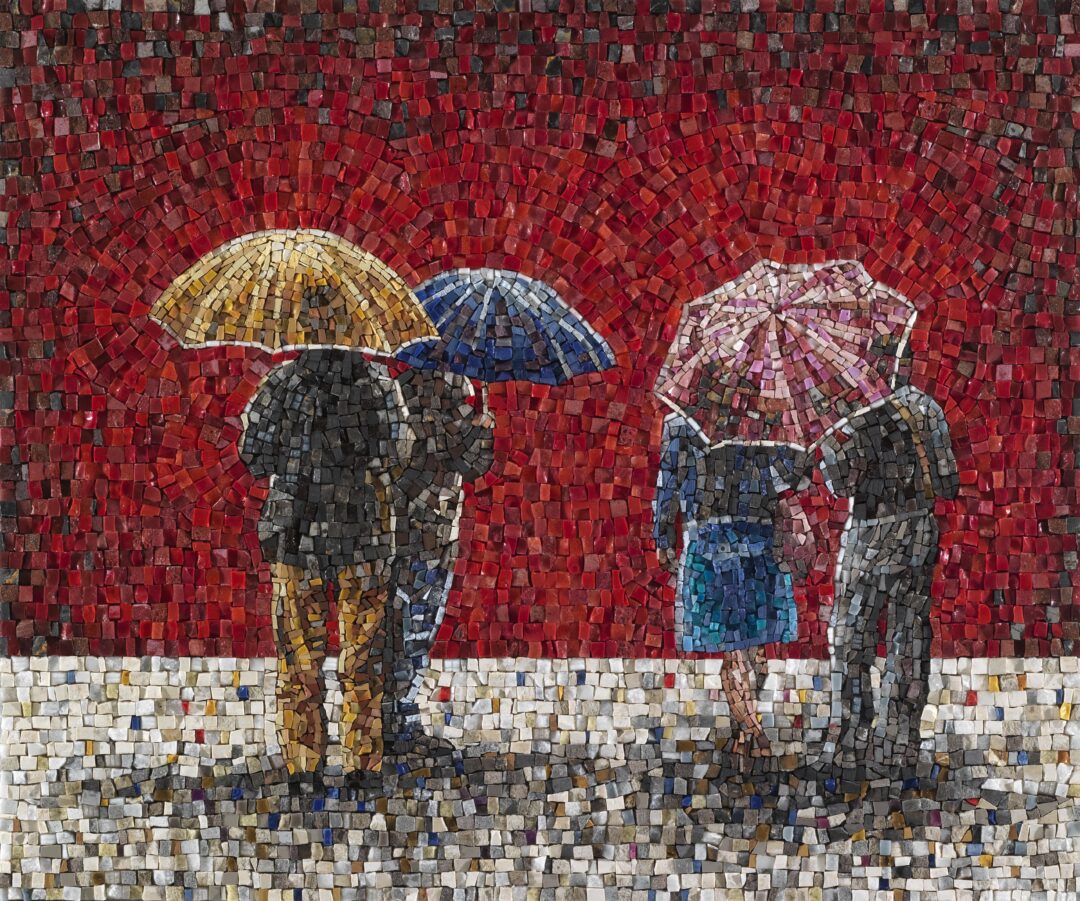
In your works there is a strong sense of nostalgia. We also observe the aesthetics of the 50s or 60s. What prompted this choice?
Human figures with their physical presence-absence is definitely my theme. It is also the theme of all of us. People come and go in and out of our lives until they are finally silenced. But I am not interested in specific people in order to depict them realistically. I create figures that are a little impersonal, like shadows, that can be many people at once. I am interested in their positioning in the composition of the work, their posture and their movement that conveys the idea of time.
Not their physical characteristics. After all, very often they are covered by colorful umbrellas, symbolizing protection from an invisible rain, or the problems of our lives. In the last section of my works, they wear clothes from the fifties or sixties, trench coats and suits that recall the figures of our parents (for those close to my age), because that was, as they say, the last period of “innocence”. Now the world has changed, and the speed of change, technology and vested interests have made an explosive mix that we want to escape from and indulge in something simple, more human, more silent, like the solitude of the night. We want a standstill in things, we want a minimal amount of time needed to escape.
I try to create symbolic figures that convey my messages rather than getting into the depth of presenting a unique story. This is why I create a kind of “aging” on canvas, with dips, fades and blurs in the form to create a distance between the viewer and the image, as if they were looking at an old postcard.
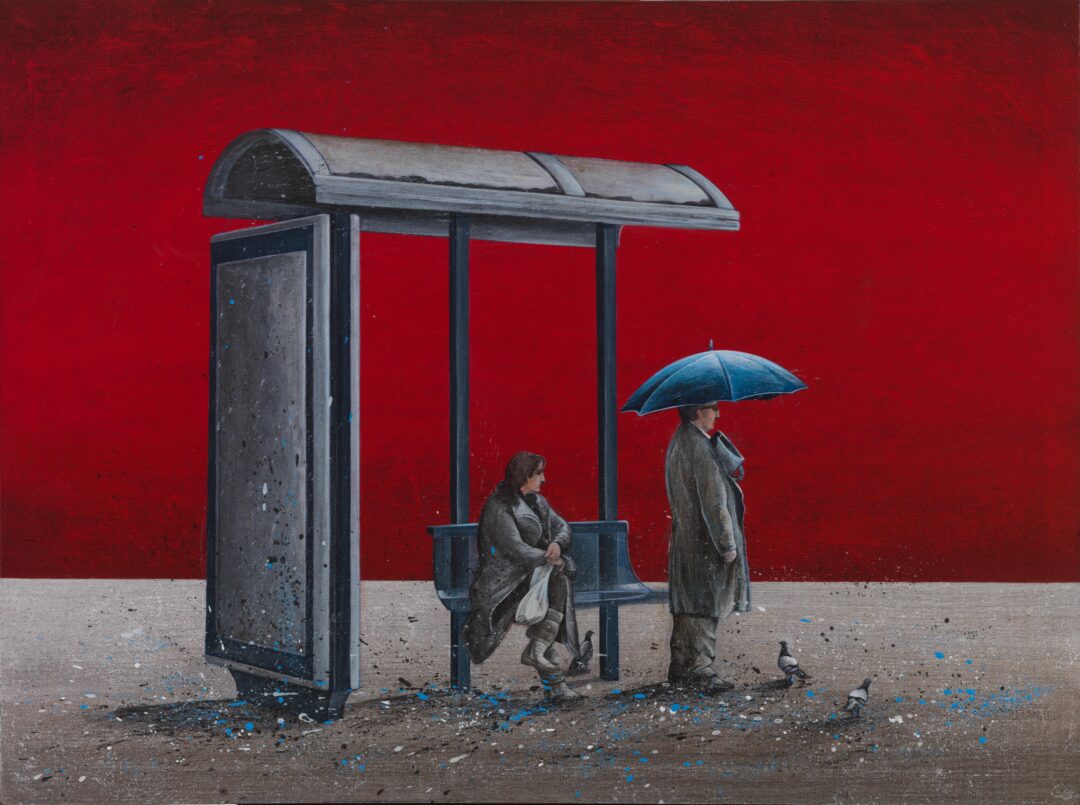
The art market consists of many ‘players’. Collectors, institutions, contemporary art museums, galleries…to what extent do they set the standard?
It is true that institutions, art historians and critics, museums and collectors influence the art market and set prices. Artists, of course, are also involved. Those who are not involved take their time to do their work and usually have much lower prices, since they do not compete abroad.
Let me point out that the art stock market ignores contemporary Greek artists, except for a few who have stayed and networked abroad (e.g. Diaspora Greeks in America etc.). In my opinion, this is due to the fact that no official state institution promotes our artists. With private initiative and funding alone, you can’t go very far.
I understand the financial situation, however, I feel sorry because I believe that, even as a small country, we could have been organizing exhibitions, festivals and conferences on art, philosophy and poetry, so that we could have high-quality tourism.
Originality is an easy way to make work stand out. It’s not necessarily bad, but we often miss the point, and the pursuit of originality ends up sterile and dead-end. Great art needs no gimmicks, as it refers to timeless concepts in a way that they stand the test of time and different societies.
As a professor, you are close to young artists, with talent and dreams for the future. How easy is it for them to establish themselves in such a competitive field as the art market? Do you feel that the ASFA provides the right tools? Who are the ones who will ultimately succeed to stand out?
Our students are wonderful young people who have survived an uncaring society before coming to our school. They are lagging behind visual education, but they quickly catch up with a drive that I sometimes admire. Of course, there are also students who are more compromised and believe they have to succeed, otherwise, failure will haunt them all their lives.
Let me tell you about the Mosaic workshop of the ASFA., where I work with two excellent collaborators, the sculptor, painter and mosaic painter Angeliki Kokonaki and the painter and mosaic painter Dimitra Antonopoulou.
Our students share a great love for the ancient and Byzantine traditions, but they mainly create contemporary artworks. They approach this ancient Greek art with love, respect and sensitivity, and review its unique characteristics. With ingenuity and interesting experimentation, they show us that the medium is not an end in itself, but the point is the artistic search. Our school tries to function as a big embrace, giving the children specialized knowledge, but also a friendly environment so that they can live, work, experiment and develop their artistic style. We strive to help our young artists take their first steps in the field, and most importantly to believe in themselves and their art. The art market, everywhere, is indeed a “wild” and inhospitable place, but I am happy to see that students make their dreams come true, in Greece or abroad. We are one of the most successful universities in terms of connecting studies and the job market. I don’t mean that our graduates make a lot of money, except for a few, but they do what they have studied and love. I am very optimistic that just as water finds its way and moves on, our students will be able to continue to develop their art and make their dreams come true, contributing to the progress of our society, which is in dire straits.
*Interview by Dora Trogadi
TAGS: ARTS

